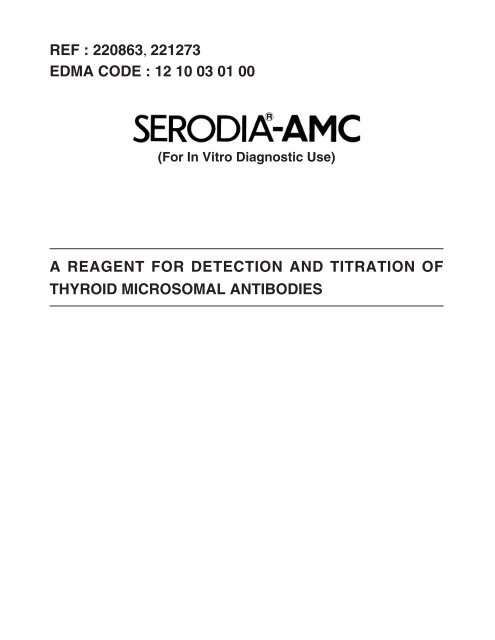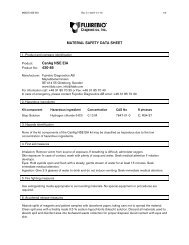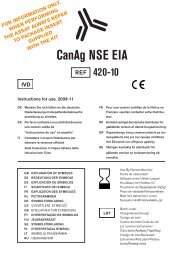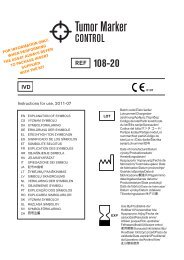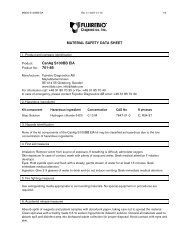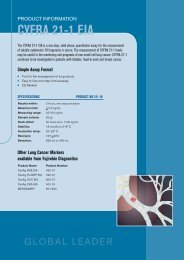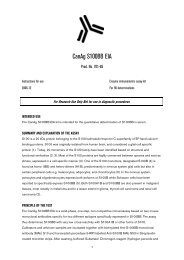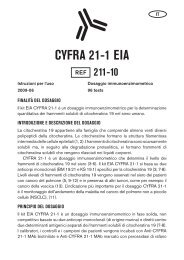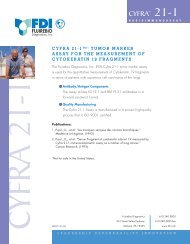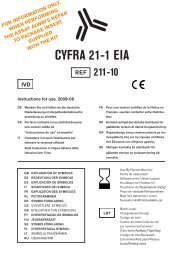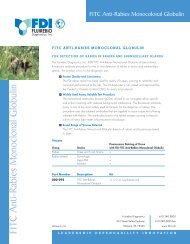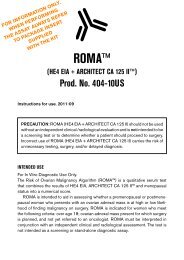AMC_PI_704 rev.pdf - Fujirebio Diagnostics, Inc.
AMC_PI_704 rev.pdf - Fujirebio Diagnostics, Inc.
AMC_PI_704 rev.pdf - Fujirebio Diagnostics, Inc.
Create successful ePaper yourself
Turn your PDF publications into a flip-book with our unique Google optimized e-Paper software.
REF : 220863221273EDMA CODE : 12 10 03 01 00(For In Vitro Diagnostic Use)A REAGENT FOR DETECTION AND TITRATION OFTHYROID MICROSOMAL ANTIBODIES
TABLE OF CONTENTS1. INTENDED USE ..................................................................................32. SUMMARY AND EXPLANATION ...................................................33. PRINCIPLE OF THE TEST .................................................................34. MATERIALS SUPPLIED ....................................................................45 MATERIALS REQUIRED BUT NOT SUPPLIED.............................56. PRECAUTIONS ...................................................................................57. STORAGE ............................................................................................68. SPECIMEN COLLECTION AND PREPARATION...........................79. PREPARATION OF REAGENTS .......................................................710. ASSAY PROCEDURE.........................................................................711. INTERPRETATION OF RESULTS ....................................................912. CRITERIA FOR INTERPRETATION.................................................913. ABSORPTION PROCEDURE...........................................................1014. QUALITY CONTROL .......................................................................1015. LIMITATIONS ...................................................................................1116. EXPECTED RESULTS ......................................................................1217. PERFORMANCE CHARACTERISTICS..........................................1218. REFERENCES....................................................................................13English-2
1. INTENDED USESERODIA-<strong>AMC</strong> is a semi-quantitative microtiter particleagglutination test for the in vitro diagnostic detection and titration ofmicrosomal antibodies in human serum.2. SUMMARY AND EXPLANATIONAutoimmune diseases can comprise conditions in which structural orfunctional damage, or both, is produced by humoral and cellmediatedimmune reactions with normal components of the body.These may be classified as tissue specific or generalized.(l) An organspecific disease such as chronic thyroiditis (Hashimoto's disease)may commonly produce antibodies to thyroglobulin or microsomalantigen of the thyroid. Autoimmune thyroid disease is common,affecting approximately 1% of the population while subclinical, focalthyroiditis and/or circulating thyroid antibodies can be found in about15% of otherwise healthy subjects who are euthyroid.(l,2) In additionto being found in cases of thyropiditis, these antibodies may be foundwith other thyroid disorders, such as primary myxedema,hyperthyroidism, goiter and thyroid tumors.(1)Microsomal antibodies can be demonstrated by several procedures,such as passive agglutination. SERODIA-<strong>AMC</strong> is prepared usinggelatin particles sensitized with purified microsomal antigen. Sincethyroid autoimmune disease may demonstrate an immunologicalresponse to antigens other than microsomal antigen, SERODIA-<strong>AMC</strong> should always be used in conjunction with clinical findings andother immunological thyroid tests. A number of references pertainingto antibody agglutination tests for microsomal antibody in thyroiddiseases have been published.(3-13)3. PRINCIPLE OF THE TESTSERODIA-<strong>AMC</strong> is based on the agglutination of gelatin particlecarriers sensitized with microsomal antigen, extracted and purifiedfrom human thyroid tissue. Serum containing specific antibodies willEnglish-3
eact with the microsomal antigen-sensitized colored gelatin particlesto form a smooth mat of agglutinated particles in the microtitrationplate. Negative reactions are characterized by a compact buttonformed by the settling of the nonagglutinated particles. The test isdesigned to be used exclusively with microtitration techniques. Theagglutination patterns and interpretation are clear cut and easy toread.4. MATERIALS SUPPLIEDA:Reconstituting Solution: 1 x 11 mL for 25 Test Kit and 1 x 36mL for 100 Test Kit - Aqueous solution containing PhosphateBuffer, sodium azide (0.06% w/v), and stabilizers at pH 7.0-7.5.The solution is to be used for reconstituting the Sensitized andUnsensitized Particles.B:Sample Diluent: 1 x 30 mL for 25 Test Kit and 2 x 64 mL for100 Test Kit - Aqueous solution containing Phosphate Buffer,sodium azide (0.10% w/v), and stabilizers at pH 7.0-7.5. Thesolution is used for diluting human serum in the assay.C:Sensitized Particles: 5 x 1.5 mL for 25 Test Kit and 5 x 6.0 mLfor 100 Test Kit - Lyophilized preparation of tanned gelatinparticles sensitized with microsomal antigen containing sodiumazide as preservative. At the time of use, add the ReconstitutingSolution as prescribed on the vial label. The rehydrated reagentcontains a 1% suspension of sensitized gelatin particles. (sodiumazide 0.08% w/v after reconstitution)D:Unsensitized Particles: 3 x 0.5 mL for 25 Test Kit and 3 x 1.2mL for 100 Test Kit - Lyophilized preparation of tanned gelatinparticles containing sodium azide as preservative.At the time of use, add the Reconstituting Solution as prescribedon the vial label. The rehydrated solution contains a 1%suspension of unsensitized gelatin particles. (sodium azide 0.11%w/v after reconstitution)English-4
E:Positive Control (goat): 1 x 0.2 mL for 25 Test Kit and 2 x 0.2mL for 100 Test Kit - This liquid serum containing goatantibodies to microsomal antigen should demonstrate a titer of1:1,600 final dilution when tested according to the proceduredescribed below. Control contains sodium azide (0.10% w/v) aspreservative.F:Dropper: 2 pcs. in 25 Test Kit and 4 pcs. in 100 Test Kit - Todispense approximately 25 µL per well. One dropper to be usedexclusively for dispensing reconstituted Sensitized Particles andthe other dropper for dispensing the Unsensitized Particles.5 MATERIALS REQUIRED BUT NOT SUPPLIED1. “U” shaped microplate2. Calibrated pipette droppers - to dispense approx. 25 µL.3. Micro-pipettor with tips - to dispense 25 µL- for dispensing anddiluting serum samples.4. Pipettes - 1.0 mL and 5.0 mL for reconstitution and 10 µL fordispensing.5. Plate mixer (automatic vibratory shaker)6. Plate viewer6. PRECAUTIONS1. For in vitro diagnostic use only.2. All reagents should be brought to room temperature before use.3. Proper plate mixing, after addition of all reagents, is important.Use an automatic vibratory plate mixer or tap the plate sharplywith your finger or against a hard surface such as the side of aworkbench to assure proper mixing. The use of a rotator, such asthose used for RPR card test will not give adequate mixing.4. During incubation, cover the microplate and keep free fromvibration.English-5
5. Reuse of microplates is not recommended. However, ifmicroplates are to be reused, it is critical that special care betaken when cleansing the microplate before reusing it, otherwisethe reaction may be adversely affected. Be sure not to leave anydisinfectant or detergent residues on the plate. Only high quality,rigid, “U” shaped microplates, such as <strong>Fujirebio</strong> FASTEC plates,should be used for the assay. Plates with oil residue or othersurface contaminants will interfer with the test results.6. Do not intermix reagents from different kit lots.7. Ideally, the lyophilized reagents in this kit should be used on thesame day as reconstituted. However, when stored at 2-10°C, theyhave a reconstituted stability of 7 days8. Reagents contain small amounts of sodium azide as preservative.Sodium azide may react with lead or copper plumbing whichmay result in the formation of highly explosive metal azides. Ifthese reagents are to be disposed of in a laboratory sink, flushwith generous amounts of water to avoid azide build-up.9. Do not pipette patient specimens by mouth (use precisionpipetters). All solutions should be handled as if capable oftransmitting HIV, Hepatitis or other potentially infectious agents,and disposed of as potential biohazards at “Biosafety Level 2” asrecommended in the CDC/NIH Manual “Biosafety inMicrobiology and Biomedical Laboratories”, 1984 or latestedition.10. Use separate pipette tips for each sample, control and reagent toavoid cross contamination.11. Avoid freezing reagents contained in the kit.7. STORAGEStore all reagents at 2-10°C both before and after opening orEnglish-6
econstitution. DO NOT FREEZE. Reconstituted Sensitized andUnsensitized Particles should be used within 7 days. Liquid reagentsare stable through the labeled expiration date. Do not use reagentsafter the expiration date marked on the kit.8. SPECIMEN COLLECTION AND PREPARATIONThe specimen for this kit is serum free of particulate matter.Specimens containing erythrocytes or other visible matter should becentrifuged to testing to p<strong>rev</strong>ent interference with test results. Storesera in a refrigerator at 2-8°C. Sera may be frozen and thawed once.Heat-inactivation is not necessary for the patient sera, however,p<strong>rev</strong>iously heat-treated sera may be used.9. PREPARATION OF REAGENTS1. Reconstituting Solution, Sample Diluent and Positive Control areliquid ready for use and require no reconstitution.2. Sensitized Particles and Unsensitized Particles must bereconstituted with the Reconstituting Solution using the volumelisted on the vials. Once opened, dispense the appropriate amountof Reconstituting Solution. Mix reconstituted reagentsthoroughly and allow to stand for at least 30 minutes prior to use.Mix again prior to dispensing.Reconstitute the reagents following the Table 1 below:ReagentSensitized Particles (Vial C)Unsensitized Particles (Vial D)Table 1Volume of Reconstituting Solution100 Test Kit25 Test Kit6.0 mL1.5 mL1.2 mL0.5 mL10. ASSAY PROCEDURE1. Uses “U” shaped microplate sideways. One row (12 wells) isEnglish-7
necessary to test one patient sample.2. Using a pipette calibrated to deliver 25 µL, place 2 drops (50 µL)of Sample Diluent into well #1 and #2 and 3 drops (75 µL) intowells #3 - #12.3. Using a micropipette, add 10 µL of serum specimen or PositiveControl into well #1. Mix well by filling and discharging themicropipette 3 or 4 times with fluid in well #1. Then draw up 25µL of the diluted solution in well #1 with a micropipette andtransfer it into well #2. Mix well again and transfer 25 µL intowell #3. Repeat mixing and transfer through well #12 to obtain afour-fold dilution.4. Place 1 drop (25 µL) Unsensitized Particles into well #2 and 1drop (25 µL) of Sensitized Particles into wells #3 through #12using the droppers supplied in the kit.5. Repeat the above steps for each patient specimen and PositiveControl.Table 2Well No.12345612Sample Diluent (µL)Serum Specimen orPositive Control (µL)5010502575257525752575257525(discard)25LTest Specimen Dilution1:61:181:721:2881:1,1521:4,6081:18,874,368UnsensitizedParticles (µL)25SensitizedParticles (µL)2525252525Final Dilution1:271:100*(10 2 )1:400(20 2 )1:1,600(40 2 )1:6,400(80 2 )1:26,214,400(5,120 2 )Mix the content using a plate mixer, cover the plate and incubate for 3 hoursInterpretationEnglish-8
6. Mix the contents of the wells thoroughly using a plate mixer(automatic vibratory shaker) or tapping plate with finger. Thencover the plate and place it on a level surface. Allow it to stand atroom temperature (15-30°C) for 3 hours (or overnight, if desired)and read the patterns.Mix the plate using a plate mixer (automatic vibratory shaker),cover the plate and incubate for 3 hours, or overnight if desired.Protect from vibration during incubation11. INTERPRETATION OF RESULTSResults are obtained by reading the settling patterns of the coloredgelatin particles using a plate viewer. Carefully place the microplateon a plate viewer (with indirect lighting), and compare theUnsensitized Particle Control agglutination patterns with those of thePositive Control. Readings are scored using the criteria shown inTable 3:Table 3Settling Patterns of ParticlesParticles are concentrated in the shape of a button at thecenter of the well. There is a smooth round outer margin.Particles are concentrated to form a compact-ringshape with a smooth outer margin.Particles form a large ring with a rough multiformouter margin. Peripheral agglutination occurs.Firmly agglutinated particles spread out covering thebottom of the well uniformly.Reading(–)(±)(+)(++)InterpretationNon-ReactiveIndeterminateReactiveReactive12. CRITERIA FOR INTERPRETATION1. ReactiveA specimen showing Non-Reactive with Unsensitized Particles(final dilution 1:27), but demonstrating a reaction of (+) or moreat any dilution 1:100 or greater with Sensitized Particles isEnglish-9
interpreted as REACTIVE.2. Non-ReactiveRegardless of the reading of reaction pattern with UnsensitizedParticles, a specimen showing (-) with sensitized Particles (finaldilution 1:100) is interpreted as NON-REACTIVE.3. IndeterminateA specimen showing (-) with Unsensitized Particles (finaldilution 1:27) and demonstrating (±) with Sensitized Particles(final dilution 1:100) is interpreted as INDETERMINATE.13. ABSORPTION PROCEDUREIn most Cases, test specimens do not show agglutination withUnsensitized Particles. However, if a test specimen produces (±) ormore with Unsensitized Particles and Sensitized Particles, retest afterthe following absorption procedure:1. Add 250 µL of reconstituted Unsensitized Particles into a smalltest tube.2. Add 50 µL of test specimen, mix thoroughly using tube mixerand incubate at room temperature for 30 minutes (mix manually1 or 2 times).3. Centrifuge for 5 minutes at 2,000 r.p.m. Place 50 µL ofsupernatant (absorbed 1:6 diluted specimen) to well #1 of theplate. Add 50 µL (2 drops) of Sample Diluent into well #2 and 75µL (3 drops) into well #3 through #12. Using a micropipette,transfer 25 µL of well #1 (absorbed 1:6 diluted specimen) intowell #2. Mix completely by filling and discharging themicropipette 3 or 4 times with fluid in well #2. In order to make afour-fold dilution, repeat the same procedure for the rest of thewells, from well #3 to well #12, as shown in Table 2.4. Place 1 drop (25 µL) of Unsensitized Particles in well #2 and 1drop (25 µL) of sensitized Particles is well #3 through #12.English-10
5. Then follow the original procedure and read the patterns.14. QUALITY CONTROL1. The Positive Control should be processed at least once on the dayof testing or when a batch of specimens are run.2. Confirm that the reaction of each specimen and UnsensitizedParticles (1:27 final dilution) is non-reactive (-).3. The mixture of Sample Diluent either with reconstitutedSensitized Particles or Unsensitized Particles should be nonreactiveon any run of tests. (Reagent Control)4. Confirm that the titer of the Positive Control is 1:1,600() at final dilution, according to the test procedure outlinedin Table 2.15. LIMITATIONS1. SERODIA-<strong>AMC</strong> test is specific for detecting microsomalantibodies.2. Since thyroid autoimmune disease may demonstrate animmunological response to antigens other than microsomal, thistest should always be run in conjunction with a thyroglobulinantibody test, In thyroid autoimmune disease, the frequency ofpositive results with the microsomal antibody test has beenshown to be higher than with thyroglobulin antibody test. (6)However, in some cases, a positive thyroglobulin antibody testcan be obtained while the microsomal antibody test results arenegative.3. In other autoimmune disorders, such as Sjogren Syndrome,Systemic Lupus Erythematosus (SLE), rheumatoid arthritis (RA),and autoimmune hemolytic anemia, there is a serologic overlapin which positive reactions may occur with the thyroglobulin andmicrosomal antibody tests. Antithyroid antibodies, particularlymicrosomal antibodies, are found in other thyroid disorders andin other autoimmune diseases such as pernicious anemia,English-11
myasthenia gravis, SLE, and rheumatoid arthritis. (10-12)4. It has been reported that thyroid autoantibodies have beendetected in the sera of patients with other organ-specificautoimmune manifestations. This overlap with other autoimmunedisorders suggests that other immunologic tests may be indicatedin some patients. (3-13)5. Some sera samples with high antibody titer may exhibit theprozoning phenomenon at lower dilutions. When prozoningoccurs, the agglutination patterns at low dilutions will exhibit anon-reactive appearance. Upon further dilution, the agglutinationpattern will appear as reactive. It is important to dilute allsamples through the 12th wells to obtain correct results.16. EXPECTED RESULTSThyroid antibodies are seldom found in serum of normal patients.However, 2-17% of the normal population may exhibit low titers ofthyroid antibodies with no symptoms of disease. (12,13) Theincidence is higher in women and increases with age. The presence ofthyroid antibody may also be indicative of p<strong>rev</strong>ious autoimmunedisorders. Patients with low thyroid antibody titer should be testedperiodically, as the presence of the antibody may be an early sign ofautoimmune disease.In active cases of thyroid autoimmune disease and in some cases ofthyrotoxicosis, moderate (1:1,600) to very high (1:25,600) antibodytiters may be observed. The detection of very high (1:25,600)antibody titers in an individual with a firm, hard, fast-growing,symmetrical goiter strongly suggests Hashimotoís goiter. (6,9-13)Normal or only slightlyelevated titers of thyroid antibodies constitutesome evidence against the diagnosis of immune thyroiditis. (12,13)Serum demonstrating a reactive result at any dilution should beinterpreted in accordance with clinical findings. Diagnosis of thyroidautoimmune disease should not be made on the basis of themicrosomal antibody test alone, but in conjunction with otherEnglish-12
immunological tests, thyroid function tests, physical examination,familial studies, and, if necessary, biopsy.17. PERFORMANCE CHARACTERISTICSStudies were performed in <strong>Fujirebio</strong> laboratories and in two clinicalsites comparing the performance of the SERODIA MicrosomalAntibody Test with gelatin particles (y) to the SERODIA test withsheep erythrocytes (x). The in-house study was performed using themicro technique (micro hemagglutination) for the SERODIA testwith erythrocytes; both clinical studies used the macro technique(macro hemagglutination).The study performed in-house showed the following statistics:n = 100; Y = 1.025x + 0.034; r = 0.955.In all but one case, there was no more than one well difference intiter (one specimen showed a two well difference).(5)The first clinical study tested sera from 65 patients; the correlationcoefficient was r = 0.953. (3) The second clinical study tested276 specimens, 98 of which gave a positive titer by one or both tests.This study showed a positive coincidental rate of 99%.A slightly lower titer was occasionally obtained with the SERODIAtest with gelatin particles when compared to the hemagglutinationtest. This is attributed to a lower frequency of nonspecificagglutination when using the gelatin particles. (3-4)18. REFERENCES1. Bigazzi, P.E., and Rose, N.R., Tests for antibodies to tissuespecificantigens, In: Manual of Clinical Immunology, 2nd ed.(N.R. Rose and H. Friedman, eds.) ASM, Washington, DC.,1980, pp. 874-885.2. Weetman, A.P., Autoimmune thyroiditis: predisposition andpathogenesis, Clinical Endocrinology, 36, 1992, pp. 307-323.English-13
3. Tsuchiya, H., etal., Study of a reagent for the measurement ofmicrosomal antibody titer, SERODIA-<strong>AMC</strong>, Yugawara WelfareAnnuity Hospital, Central Testing Laboratory, Japan.4. Abiko, H., et al., Experience of evaluating SERODIA-ATG and<strong>AMC</strong>, Central testing Dept., Affiliate Hospital to TohokuUniversity, School of Medicine, Japan.5. SERODIA-ATG and SERODIA-<strong>AMC</strong> Tests, <strong>Fujirebio</strong>, <strong>Inc</strong>.,Tokyo. Japan.6. Ravel, R., Thyroid function tests, In: Clinical LaboratoryMedicine, 4th Ed., Chicago, 984, p.366.7. Beeson, P.B. and McDermott, W., (eds). Diseases of theEndocrine System,. In: Textbook of Medicine., 14th Ed.,Philadelphia, W.B. Saunders Co., 1975, p.1716.8. Fischback, F.T., Thyroid hemagglutination tests, In: A Manual ofLaboratory Diagnostic Tests, Philadelphia, J.B. Lippincott Co.,1980, pp 417-418.9. Gornall, A.G., Luxton, A., and Shavnani, B.R., EndocrineDisorders, In: Applied Biochemistry of Clinical Disorders, 2ndEd., (Gornall, A.G., ed.), Philadelphia. W.B. Saunders Co., 1979,p. 1278.10. Zweiman, B., and Lisak, R. P., Autoimmunity and AutoimmuneDisease, In: Clinical Diagnosis and Management by LaboratoryMethods, (Henry. J.B., ed.), 16th Ed., Philadelphia. W.B.Saunders Co., 1979, p. 1278.11. Ingbar, S.H., and Woeber, K.A., Diseases of the Thyroid, In:Harrisonís Principles of Internal Medicine, 9th Ed., (Isselbacher,K.J., et al. Eds), New York, McGraw Hill Book Co., 1980,p.1711.12. Crolla, L.J., and Maso, C.J., Immunologic Studies of theEndocrine System, In: Clinical Immunochemistry, (Natalson, S.,Pesce, A.J., and Dietz, A.A., eds). Washington, DC, AACC,1978, pp. 282-284.English-14
13. Williams, D.L. and Goodburn, H., The Thyroid Gland, In:Biochem. In Clinical Practice, (Williams, D.L. and Marks, V.,eds) New York, Elsevier Pub. Co., 1985, pp. 567-575.Authorised Representative:FUJIREBIO EUROPE B.V.Takkebijsters 69c 4817 BL Breda, TheNetherlandsTEL:31-76-571-0444Manufacturer:FUJIREBIO INC.62-5 Nihonbashi-Hamacho 2-chome,Chuo-ku, Tokyo, 103-0007, JapanTEL:81-3-5695-9217Revised in July, 2004English-15


